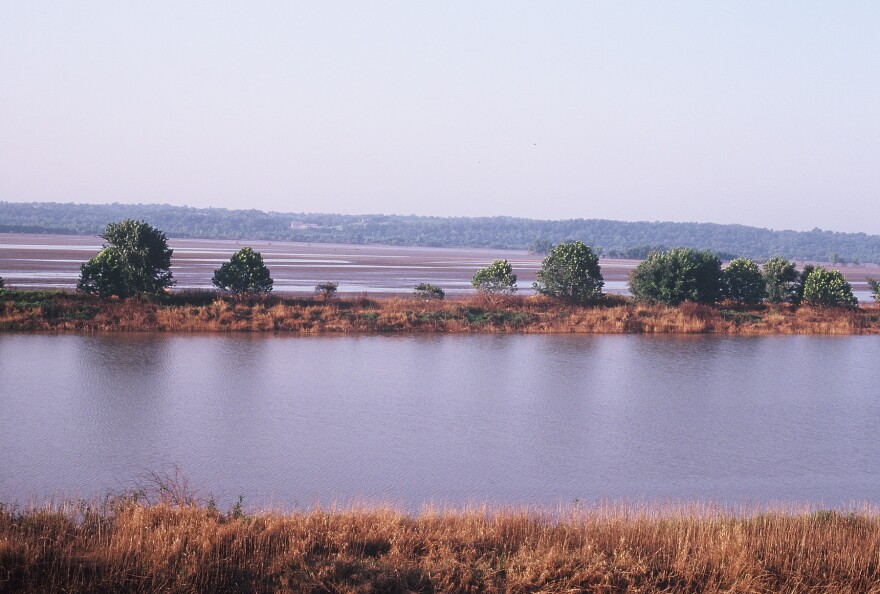Twenty years ago this summer, monsoon-like rains, unseasonably heavy snowfall and unusual air pressure patterns combined to cause massive flooding across nine Midwestern states.
47 people died. Tens of thousands were forced from their homes, water inundated 75 towns and destroyed millions of acres of farmland. Damages were estimated at $20 billion dollars.
I covered the floods for NPR in 1993, and went back to revisit some of the people and places affected by what’s still called The Great Flood.
A powerful flood
You don’t expect to hear the words “mass grave site” in a conversation about a an old cemetery in a tiny Missouri River hamlet like Hardin. But when a break in a levee sent the swollen river rushing over the graveyard there, it separated caskets from soil and made of mess of the graves.
Coffins were found floating throughout the floodplain for weeks and when many were found, the remains were too hard to identify. Cemetery caretaker Steve Shirley said the only thing to do was establish a mass grave.
“(We) buried all the unknowns in a mass grave site here… about 800,” he says.

There were so many exhumed coffins, Shirley says, they had to line them up at the county fairgrounds while coroners and volunteer funeral workers tried to identify them.
The flood water gouged out a small lake in the middle of the cemetery and on one side, a handful of the original tombstones stand in random order. On the other side of the lake, stones are set in symmetrical rows, one behind the other. These were the tombstones the flood washed away.
Shirley says many of them were at the bottom of the lake.
“You can kind of see for example, the Meador stone was stained by the water," he says. "We just recovered and reset ‘em and cleaned ‘em up a little bit.”
Volunteers and cash donations came in from as far away as Germany, and when the graveyard was restored, officials erected a marble memorial with the names of the 800 or so bodies that were never recovered etched in the stone.
Terry Johnson’s grandparents were among the 80 or so bodies never found. Today, she regularly visits the cemetery to remember her grandmother, even if it’s just to the mass grave. She says she’s honoring her grandmothers wishes.
“Grandma used to always say, ‘now I want you to keep flowers on my grave,'" she explains. "So at least I’ve got the stone where I can decorate the grave.”
Relocating to higher ground
The town of Pattonsburg, Mo., up I-35 through the Missouri River Basin, suffered losses of a different kind.
Surrounded by tributaries and creeks, Pattonsburg was flooded two different times in July of 1993, and became one of a number of entire cities the Federal Emergency Management Agency, or FEMA, bought out.
Officials were encouraging people in flood-prone properties to relocate to higher ground. When the Missouri River crested at record levels in July, former school superintendent Gene Walker said the area filled up like a bathtub.
“One of the people from Chicago said, 'why, I don’t know why you folks are next to the river,'" says Walker.
"Well, they’re all working on assumption we sitting on our porch fishing in the river. It’s two miles (from) the river to the edge of town where dike is. It filled that entire area UP with water and then came over the dike.”

FEMA came in, appraised each property, and offered the town $12 million. Businesses and public buildings weren’t included. Gene Walker says not everyone was happy.
“You put that many people in a room and throw a rock in, some people will like the rock and some people won’t," he says. "We had folks who left with a smile and thought they did real well and others who said, ‘no, I didn’t get enough.'”
After a series of long community meetings, and consultations with architects and engineers, most took the money and the option to move. Once the town was torn down, the local government rented the acreage to farmers. Director Ang Lee doctored the demolished street front to use for his movie Ride With The Devil.
Superintendent Gene Walker cruises his SUV along the naked roads of the former town, now just soybean fields. As he idles his engine at a cross roads in front of a street sign bent 45 degrees to the ground, he tries to remember which streets were which.
He points out there once was a bowling alley, watch repair shop, bank and hardware store where an expanded farm cooperative now stands, and we continue our tour of Pattonsburg with a drive up to the new town, a mile or so away.
A few of the old businesses have moved up to New Pattonsburg, as residents call it, the commercial center is called, perhaps appropriately, Main Street. It’s a short block separated by a grassy median, and some of the only trees in the area. The shops are a stone's throw away from larges houses with large lawns.
There is a distinctive movie-set feel here, as if the whole place was lifted up and dropped on some farm fields - kind of like Dorothy’s house landed in Oz. Residents toodle around in small vehicles, seeming to pull up out of nowhere.
Gene Walker waves to an elderly resident driving up his driveway in a golf cart.
“Casey drives his golf cart around, rather than get his car out. (He) thinks it’s a lot simpler,” says Walker.
Parking is a premium as people visit the chiropractor and consignment shop, or The Old Memories Café and Pinkies sub shop, which both do a brisk lunch trade.
The town may seem surreal, but you can tell how planners considered real-life problems in the new town’s design. The new school is a series of space-aged domes that are energy efficient and sustainable. There’s a retirement community and low-income housing. The back streets are a patchwork a newly built homes and those that were lifted from off their foundations and moved up here.
Gene Walker points to his own 19th century Victorian and says everyone made their own choice about what to do with their home.
“See, they moved all of it," he says of his home. "There’s the leaded glass and stained glass windows….”
Deciding To Stay Put

Our tour of Pattonsburg takes us back down to the river bottoms. Lyle and Donna Warford were one of the few families who stayed put after the floods.
As Donna welcomes us into her sprawling ranch home, shaded by a massive oak tree, she explains there was up to four feet of water when she came in after the second flood.
They found mud and silt in the sink and putrid water covering her antique furniture. They lost most all of their livestock, but they found two animals in an unlikely place. “
We had a Siamese cat and a 40 pound pig on the table who floated in and didn’t know where to go," she says.
Donna’s mother’s hand-sewn quilts were soaked and many of their antique clocks swept way. Lyle and Donna both get emotional when the remember the help they got after the floods, from friends, strangers, even prisoners from the Cameron Corrections facility.
“There is always someone worse off than you are," says Donna, "probably the best part is the help we had. (There) is never any way we can repay the people who helped us.”
Lyle's dad was the mayor in the 40’s, and the Warford’s son is mayor now. Donna says it would be very hard for them to move away.
“Roots get planted pretty deep..., I’m not saying we ever want to experience another flood, but this is home,” she says.

The Warfords got the same disaster relief as everyone else in Pattonsburg- $10,000, and an offer on their home if they wanted to relocate. Lyle estimates it would have cost 20 times what they were offered, so he turned down the deal. Because he’s outside the city limits, he’s still not eligible for flood insurance.
They know they’ve made a tough choice, but Donna says if it’s not raining, they don’t think about it.
Army Corps of Engineers flood management specialist Judd Kneave says it’s fine for those who want to stay in the floodplain to stay there, as long as they remember they are always at risk.
Preventing Another Flood
Strolling along the gravel bike path atop the well- manicured L385 levee in in Riverside, Mo. Kneave points out the new technology - gates and drainage pipes – designed for flood control.
This was a small agricultural levee in ’93, like many that were involved in the floods. Since then, the Corps and local governments are collaborating more in an effort to maintain the quality of levee system.
But Kneave says the Corps primary focus is to communicate a new message.
“The biggest change fund in the last 20 years for the Corps is were putting a lot of emphasis on communicating that when you live and work in a flood plain, you’re always at risk," says Kneave.
"It doesn’t matter what kind of flood management project was constructed to help you.”
In 1993, and again during floods in 2011, critics claimed the Corps made bad decisions in efforts to mitigate the impact of flooding. They say politics, as always, played too great a role. But as development creeps back into the floodplain, even top experts agree the focus must be on the message; if you live near the river, you’re never immune from the impact of floods.



